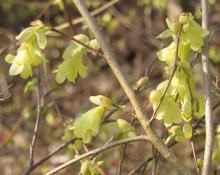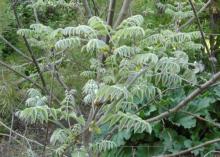Hi all,
I have a question about trees. I've posted this question on the SRGC forum too, but I'd like as many opinions as possible:
I'm going to start transforming a part of our meadow into a woodland and I'm wondering which trees (and shrubs) would be good to create shade there. It would be best if they don't compete to much with the plants I want to put underneath (Trillium/ Jeffersonia/Glaucidium/Jeffersonia/Adonis/Epimedium/...). Since I'm a newbie in the area of trees (I've been shade-gardening under the trees which were already present in the garden) any and all advice would be welcome.
Comments
Re: Trees for a woodland
Good topic and one that I feel passionate about.
Sounds like these trees will initially have sun or good light, eventually to make a canopy for underplanting with woodland plants. The key thing about this exercise, is selecting trees that allow underplanting (trees with upright habit or ones that can be "limbed up", trees that are tap-rooted and not competing with the roots & moisture of underplantings, trees that are light and airy allowing some light in, and possibly even trees that are late to leaf out).
First of all, I second Trond's suggestion of Hamamelis and Corylopsis.
Acer griseum and triflorum - both are slow growing small tree, with fine textured small leaves where the leaf-litter in fall doesn't have to be dealt with, fabulous fall color, tap rooted for excellent underplanting, and of course, year round fantastic copper peeling back. Various Acer species and Japanese maples would be good choices too.
Amelanchier, many species and cultivars, I love A. canadensis best; a small twiggy tree, light airy spring blossoms, snooth gray bark, good yellow to orangish fall color, and edible small fruits. A. laevis and A. arborea are taller but equally recommended.
Chionanthus virginicus (fringe tree): tap rooted, late-to-leaf out so allows spring bulbs to be underplanted, big shading leaves although growth can be somewhat open and unwieldy. Needs limbing-up to allow underplanting, and judicious pruning to curb unwieldy growth. Fabulous show of fluffy white fowers, flower drop is of no concern to understory plants. C. retusus, the Chinese fringe tree could be used, extremely showy, although large specimens I saw look very wide, dense, and possibly too shading.
Cornus florida and kousa. C. florida (particularly good white forms) would be excellent, they have the most graceful look of any tree, truly special in bloom. Not sure if the anthracnose disease that can hit this species here in the US is a problem in your area. Cornus kousa, need to select upright ascending-branched types, the tree tends to grow wide and dense, thus too shading. I grow Epimediums under C. kousa 'Milky Way', but I keep this tree heavily pruned, otherwise it would too large. The fruits are large, prolific, squishy and messy. Both species are tap rooted and allow underplanting.
Halesia; several species of Silverbells, all are really choice and truly special when covered with white hanging bells. Striated bark. Typically a fairly airy open canopy, leaves not overly large. I grow H. monticola (can get very large) and Halesia tetraptera 'Rosea' (H. carolina 'Rosea'); allows understory planting.
Magnolia salicifolia - Most magnolias are great trees for underplanting, as the tree is tap rooted without tons of surface roots. The only trouble with tmagolias can be: need to limb the trees up, the large fleshy flowers in great profusion can make a serious mess underneath the tree... no real damage or threat to the plants, it is more of a distraction of not being able to see spring blooming ephemerals under such a chaotic mass of dropped petals. The leaves are large and shading, but in the fall are rather smothering when they drop, sort of like oak leaves. Among the genus Magnolia, a good choice is M. salicifolia with small slender leaves, and narrow-petaled flowers that do not impact underplantings as much.
Oxydendron arboreum - Sourwood Tree, there is nothing finer than this all-around fantastic tree. Tap rooted, very late to leaf out so allows spring bulbs to be planted under, refined foliage that is insect resistant, delicate summer flowers, fabulous fall color.
Stewartia pseudocamellia - grow this tree because it vies for first place as the most outstanding small ornamental tree possible, for all seasons of the year. However, for underplanting it does not work well; the roots are an incredibly dense turf of surface roots that nothing can grow in. I have underplanted mine in Iris cristata, although the Iris rhizomes skim along inhabiting the top-dressing layer of pine bark mulch; the few other things I have tried under this tree (such as Epimediums) cannot compete with the tree's roots. Fantastic June-July mass display of sumptuous white flowers just like camellia blooms, excellent twiggy growth, small neat bug-resistant foliage, blazing autumn foliage, fantastic exfoliating smooth bark in tan, cream and copper shades. Not sure if other Stewartia species are as surface-root-dominant as pseudocamellia.
Styrax japonica - I love this tree, it must be limbed up, does have some strong main surface roots but not so dense as Stewartia, so stuff can be grown underneath. As with Halesia, it is a good tree to underplant with, and to be physically under when the tree is in bloom, to look upwards to enjoy sheer profusion of little dangling white bells.
This year I shall be planting out a Albizia julibrissin that I have grown from seed, the leaves are so narrow and delicate it offers a very light airy canopy, and those wonderful pink powder puff blooms in summer; I'm hoping it will be a good tree to underplant.
I'm sure there are many other possibilities. Eventually report back and let us know what you select.
Re: Trees for a woodland
if you want a man size tree, Gymnocladus dioicus (Kentucky Coffee tree) would be perfect. Leaves can easily be 2ft (61cm), but they are bipinnate and the leaflets are only 4-5cm long. In addition, leaflets are held at an angle from horizontal, so there is good filtered light. The tree is the last to leaf out in spring, and is one of the first to color (yellow) and drop in the fall. Because the leaves are so large, branchwork is very sparse and really adds a lot of winter interest. There are male trees and female trees. Most people don't like the pods, and any name cultivar will be a male. I have both a male and a female in my yard, and I prefer the female. Gymnocladus does not have surface roots. No spring flowering, to speak of.
Another great small tree is Xanthoceras sorbifolia (Popcorn tree). Racemes of 3-4cm white flowers open with a yellow center that turns pink as it ages. Large nuts are edible. A good tree for sun or as an understory tree. Yellow fall color. Good filtered shade.
Amur Maackia (Maackia amurense) is a slow growing small tree. New foliage is intensely silver in spring, and you should be able to easily grow the less hardy (zone 5-6) Maackia chinensis that is even better. The photo is take after the strong silver stage. Leaves turn to green in summer. Blooms in mid summer, flowers are upright racemes of light blue pea like flowers. Copper color bark. This tree, like the Kentucky Coffee tree, is a legume. yellow fall color. I have not found it to be shallow rooted.
I second everything that Mark says. The maples that we can grow here in the north (zone 4) are notorious water hogs and produce masses of surface roots. The ones Mark mentions are not hardy here or are just rare, so I have no experience or pertinent knowledge of them.
Re: Trees for a woodland
WOW Guys,
many thanks for the suggestions. I think I'll be able to make a start with all of these.
I'll let you know which ones I choose.
Re: Trees for a woodland
You can also use Rhodos as trees, you know! The red one is Rhododendron thomsonii among other trees and shrubs. It is now 3.5m tall.
The other one (pinkish) is Rh 'Jacksonii', a much lower shrub. They are of the same age.
Re: Trees for a woodland
The mature trees on my lot were Pinus strobus, Quercus albua Q. rubra, Cayra ovata, Acer rubrum and Ostrya virginianum all of which are limbed up which I think is a key to growing plants under them, even the pines. The understory trees were principally Hamamelis virginiana and Cratagus. I have added most of the trees Mark has mentioned as well as many others.For understory shrubs I would not neglect our North American azaleas or Kalmia latifolia for that matter



Here are some thoughts, Wim :)
I have lots of trees in my woodland - some planted and some natural.
If you grow mostly spring flowers it is wise to use trees that leaves out late or have an open canopy and not too dense foliage.
Beeches are slow leaving out but they create a very dense canopy, almost nothing grows under beeches in summer. Oaks is better but both oak and beech leaves are hard to decompose although they make very good soil for many plants. Oaks have a deep rootrun and do not compete much with perennials and bulbs. Birches are nice trees but they have shallow roots that are very greedy. Maples are fine - and you have both small and large forms. Ashes can be OK but have aggressive roots, they like a little moisture but not stagnant wet soil.
Pines are maybe the best conifers.
Hamamelis and Corylopsis are nice shrubs for the woodland.